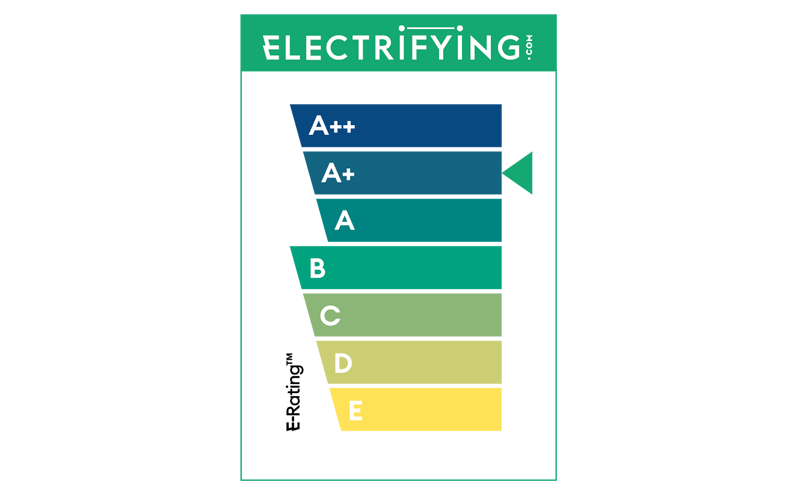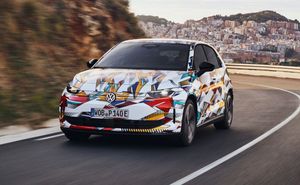The Polestar 4's overall length is 4,839 mm, width is 2,139 mm and height is 1,544 mm – that’s longer, wider and lower than a Tesla Model Y.
Of course, the most controversial aspect of the Polestar 4 is that rear window, or rather the lack of it. For what it’s worth, there is a standard full-length glass roof which stretches beyond the rear occupants’ heads, and the rear-view mirror is replaced by a high-definition screen that shows a feed from a roof-mounted rear camera. This is claimed to enable a far wider field of view than most modern cars with conventional rear-view mirrors.
As for the rest of the exterior styling, if you remember the Polestar Precept concept, then this will be looking familiar as a lot of the styling cues come from there – particularly the distinctive headlights and front bumper style, which is virtually unchanged from the concept.
It’s also worth pointing out that, because the Polestar 4 has such a low roof – it’s only 10cm higher than the roof of a Tesla Model 3, and is almost exactly the same height as the Kia EV6 – so this could also be a good option if you’re a bit tired of chunky SUVs. Just ignore the slightly misleading ‘SUV-coupé’ classification that Polestar’s given it…
Range, Battery & Charging
The Polestar 4 gets a 100kWh lithium-ion battery, 94kWh of which is usable. That means that it’ll be just the 94kWh that you’re charging and running the car on, and the remainder of those battery cells just sit around in the background, helping to keep the battery healthy for longer – something that every modern li-ion battery does.
The Polestar 4 will also be the fastest production car the brand has ever developed. Despite that performance, the official WLTP range is 367 miles for the dual motor, but most buyers will probably be happy with the 268bhp, single motor model with its WLTP range of 385 miles.
How have they managed the efficiency trick with the dual motor version? Well the front motor disconnects to improve efficiency when it’s not needed, but comes back in again when you break to capture power – increasing the amount of regen energy you can capture.
The charging from plugs comes courtesy of a conventional 400V electrical system, with peak charging rates up at an impressive 200kW – good for a 10-80% top-up in as little as 20 minutes, provided you’re plugged into a powerful enough rapid charger.
AC charging is up to 22kW, which means that you can make the most of the kerbside and lamppost charging often found in big cities. Most owners will stick with a 7kW home wallbox, which will deliver a full charge from nearly empty in around 14 hours.
Interestingly, the Polestar 4 also gets bi-directional charging as standard. This means that the car can feed energy back into the grid in return for money or, if you’ve got a clever enough system, back into your home so that you can run your property from the car’s battery when energy is at its most expensive – also saving strain on the grid at peak hours. Unfortunately, at the moment very few home chargers can support bi-directional charging – but it has been trialled extensively and we reckon that this tech will be a big factor in electric car ownership in the future. It’s great to see the Polestar featuring it as standard.
Practicality & Boot Space
If you’re worried about the back seats being claustrophobic without a rear window, don’t be. A huge glass roof runs right back to behind your head in the back seats, so it still feels pretty light and airy. The seats recline, too, for that extra touch of luxury, and even taller adults should have enough more than enough leg- and headroom.
At the back, the Polestar 4 gets a boot opening which is half way between a hatchback and a saloon’s bootlid, so access to the 526 litre space is good – and that’s also a really healthy luggage space, exactly matching the Audi Q6 e-tron. There’s some underfloor storage for your cables, or there’s a 15 litre ‘frunk’ space in the nose of the car, which you might squeeze a cable into - but only if you’re a cable-tidying ninja… The rear seats fold down in a 60/40 split, revealing a useful 1,536-litres of space.
Interior, Design/Styling & Technology
It’s all very Scandi-cool in the Polestar 4, which is characterised by the vegan, sustainable materials that the brand has championed since it was launched. The company claims that the 4 is actually the most sustainable car it makes; it uses a very limited number of materials inside to make recycling easier, and the materials it does use are mostly made from recycled plastic bottles or fishing nets. The aluminium in the body of the car is also made using hydropower electricity, and the factory where it’s built in China is powered partly by a solar array on the roof.
If you’re not a vegan then Polestar unusually offers a Bridge of Weir Nappa leather upgrade. The company says leather is sustainable as the hides are a by product of the meat industry and we all like our burgers. Without an outlet for the leather it would go to landfill, apparently. It costs £3,900 as part of a package though, so those burgers must’ve been from Five Guys rather than McDonalds.
Naturally, there’s a bevy of high-definition screens dominating the dashboard. The central 15.4-inch screen uses the same Android operating system as other Polestar models, meaning that you get in-built Google software including Google maps – which we love. Don’t worry, you’ll be able to run Apple CarPlay, as well, if you want it. A 10-inch screen forms the driver’s readout, and there’s also a huge 14.7-inch head-up display.
Some items of particular note I found while playing with the system – the ambient lighting themes are named after the planets. Besides being an interesting idea, it means you can childishly giggle about how Uranus glows blue.
There is also a Tesla-like Animal mode which allows you to keep the locked car at a pet-friendly temperature. To reassure passers-by there’s a big message on the display telling them the mode is working.
Motors, Performance & Handling
The dual motor Polestar 4 has 534bhp and is able to do 0-62 mph in just 3.8 seconds – and you’ll be able to add a Performance Pack that adds a computer-controlled sports chassis, bigger Brembo brakes and bigger wheels. Unlike the other Polestar models, there’s no more power in this version though.
Not that you need it – the twin motor version is faster than anyone could reasonably need on the public road. Push the pedal and it scenery blurs quickly enough to make you giggle, and overtakes are a breeze.
Unlike some other cars in this class and the bigger Polestar 3, this uses convention steel springs rather than air suspension and it shows. The Performance has massive 22-inch alloys and sometimes the springs struggle to keep on the right side of comfortable, even in the softest of settings.
The wheels also make the steering feel slightly odd, like it doesn’t want to move from the dead ahead position.
It’s the same story for the brakes. They are upgraded on the Performance but seem to get confused about the level of stopping they should give, especially in the mode where there is no 'creep’ selected. It makes pulling up to a junction unpredictable, as the brakes can suddenly grab.
There are three regen modes too, including a ‘one pedal’ mode which is strong enough to make your bag slide off the front seat when you lift off the pedal. I kept to the level 1 and it was nicely judged.
The non-Performance model with the slightly smaller wheels is smoother riding and generally nicer to drive. It is just as fast but less sporty, which suits this car more. The cheapest rear drive model has exactly half the power and no modes at all, but feels perfectly adequate in terms of performance. In many ways it’s the nicest to drive.
Running Costs & Pricing
The cheapest rear wheel drive version of the 4 costs £59,990 price, with the Dual Motor costing an extra £7,000. That means you’re likely to be considering rivals like the Porsche Macan, new Audi Q6 e-tron, BMW iX3 or Mercedes EQC alongside it.
The Performance Pack adds another £4,000 to the bill and there are plenty of other ‘packs’ which will soon tot up the total. Some of them are surprising, such as £900 to have body coloured side mouldings and £450 for the rear side windows to be darkened. You’d wince when ticking the box to have electrochromatic tinting for the glass roof too – it’s a £1,700 option.
The efficiency should help you recoup some of the money, the official figures suggest it will achieve just over 4 mile per kWh. That’s beaten by the new Audi Q6 e-tron and Porsche Macan though.
Verdict
The lack of rear window might be the biggest talking point of the Polestar, but there are plenty of other qualities which deserve your attention. That Scandi-cool interior is compelling and beautifully built, and the rear space is huge. The tech is easy to use and well thought through too.
None of the versions are as good to drive as a Porsche Macan or Audi Q6 e-tron, and the Performance version still feels like it wants to be a sportscar but doesn’t quite have the talent to live up to it, despite the power. However, the lesser models – especially the single motor – are much nicer to drive and cheaper too.
It’s not a class leader, but the Polestar 4 is an intriguing option. Choose one and you’ll never look back.

















